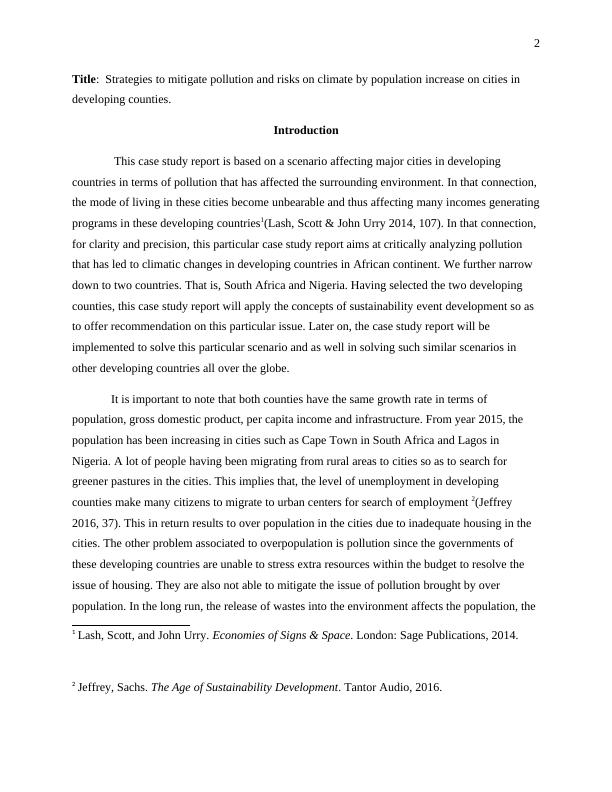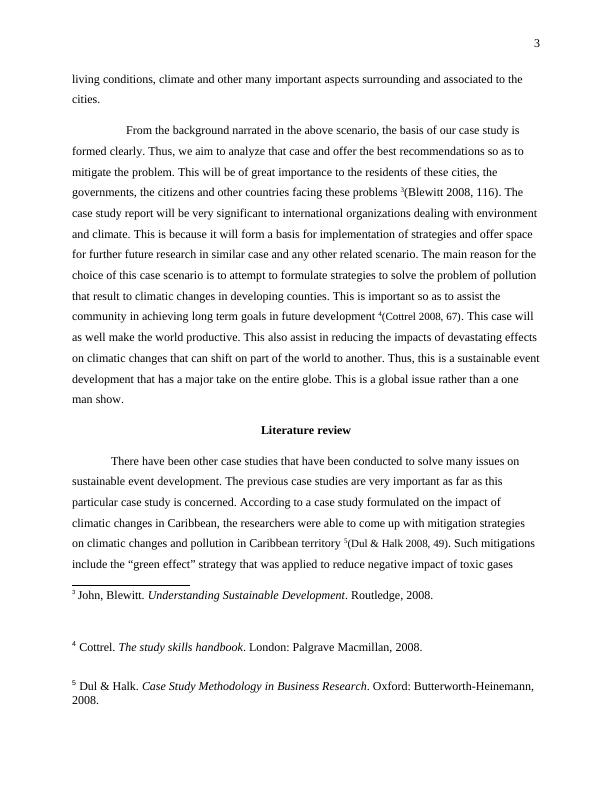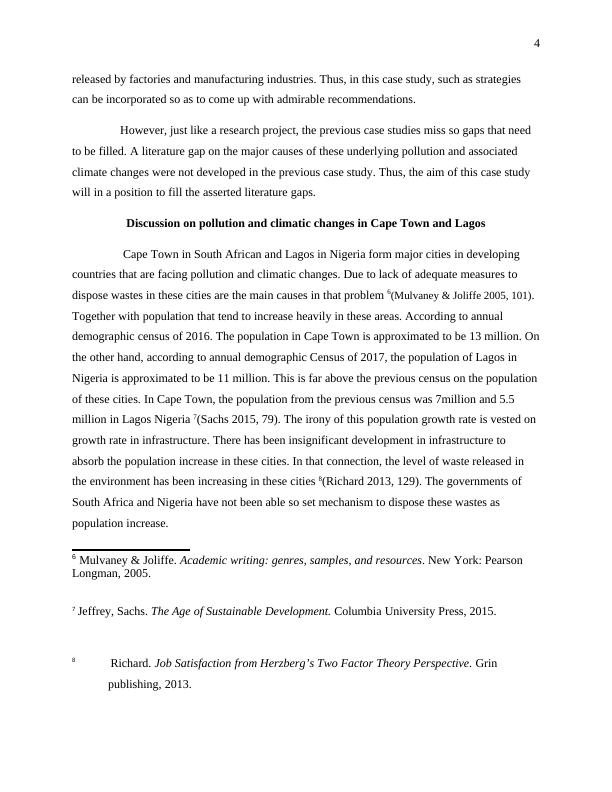Ask a question from expert
MGMT 2003 Human Resources Management
12 Pages3273 Words86 Views
Human Resources Management (MGMT 2003)
Added on 2020-04-21
MGMT 2003 Human Resources Management
Human Resources Management (MGMT 2003)
Added on 2020-04-21
BookmarkShareRelated Documents
SUSTAINABLE EVENT DEVELOPMENTName:Course:Date:

2Title: Strategies to mitigate pollution and risks on climate by population increase on cities in developing counties.Introduction This case study report is based on a scenario affecting major cities in developing countries in terms of pollution that has affected the surrounding environment. In that connection, the mode of living in these cities become unbearable and thus affecting many incomes generatingprograms in these developing countries1(Lash, Scott & John Urry 2014, 107). In that connection, for clarity and precision, this particular case study report aims at critically analyzing pollution that has led to climatic changes in developing countries in African continent. We further narrow down to two countries. That is, South Africa and Nigeria. Having selected the two developing counties, this case study report will apply the concepts of sustainability event development so as to offer recommendation on this particular issue. Later on, the case study report will be implemented to solve this particular scenario and as well in solving such similar scenarios in other developing countries all over the globe. It is important to note that both counties have the same growth rate in terms of population, gross domestic product, per capita income and infrastructure. From year 2015, the population has been increasing in cities such as Cape Town in South Africa and Lagos in Nigeria. A lot of people having been migrating from rural areas to cities so as to search for greener pastures in the cities. This implies that, the level of unemployment in developing counties make many citizens to migrate to urban centers for search of employment 2(Jeffrey 2016, 37). This in return results to over population in the cities due to inadequate housing in the cities. The other problem associated to overpopulation is pollution since the governments of these developing countries are unable to stress extra resources within the budget to resolve the issue of housing. They are also not able to mitigate the issue of pollution brought by over population. In the long run, the release of wastes into the environment affects the population, the 1Lash, Scott, and John Urry.Economies of Signs & Space. London: Sage Publications, 2014.2Jeffrey, Sachs. The Age of Sustainability Development. Tantor Audio, 2016.

3living conditions, climate and other many important aspects surrounding and associated to the cities. From the background narrated in the above scenario, the basis of our case study is formed clearly. Thus, we aim to analyze that case and offer the best recommendations so as to mitigate the problem. This will be of great importance to the residents of these cities, the governments, the citizens and other countries facing these problems 3(Blewitt 2008, 116). The case study report will be very significant to international organizations dealing with environmentand climate. This is because it will form a basis for implementation of strategies and offer space for further future research in similar case and any other related scenario. The main reason for the choice of this case scenario is to attempt to formulate strategies to solve the problem of pollution that result to climatic changes in developing counties. This is important so as to assist the community in achieving long term goals in future development 4(Cottrel 2008, 67). This case will as well make the world productive. This also assist in reducing the impacts of devastating effectson climatic changes that can shift on part of the world to another. Thus, this is a sustainable eventdevelopment that has a major take on the entire globe. This is a global issue rather than a one man show.Literature review There have been other case studies that have been conducted to solve many issues on sustainable event development. The previous case studies are very important as far as this particular case study is concerned. According to a case study formulated on the impact of climatic changes in Caribbean, the researchers were able to come up with mitigation strategies on climatic changes and pollution in Caribbean territory 5(Dul & Halk 2008, 49). Such mitigations include the “green effect” strategy that was applied to reduce negative impact of toxic gases 3John, Blewitt. Understanding Sustainable Development. Routledge, 2008.4Cottrel. The study skills handbook. London: Palgrave Macmillan, 2008. 5Dul & Halk. Case Study Methodology in Business Research. Oxford: Butterworth-Heinemann, 2008.

4released by factories and manufacturing industries. Thus, in this case study, such as strategies can be incorporated so as to come up with admirable recommendations. However, just like a research project, the previous case studies miss so gaps that need to be filled. A literature gap on the major causes of these underlying pollution and associated climate changes were not developed in the previous case study. Thus, the aim of this case study will in a position to fill the asserted literature gaps.Discussion on pollution and climatic changes in Cape Town and Lagos Cape Town in South African and Lagos in Nigeria form major cities in developing countries that are facing pollution and climatic changes. Due to lack of adequate measures to dispose wastes in these cities are the main causes in that problem 6(Mulvaney & Joliffe 2005, 101). Together with population that tend to increase heavily in these areas. According to annual demographic census of 2016. The population in Cape Town is approximated to be 13 million. Onthe other hand, according to annual demographic Census of 2017, the population of Lagos in Nigeria is approximated to be 11 million. This is far above the previous census on the populationof these cities. In Cape Town, the population from the previous census was 7million and 5.5 million in Lagos Nigeria 7(Sachs 2015, 79). The irony of this population growth rate is vested on growth rate in infrastructure. There has been insignificant development in infrastructure to absorb the population increase in these cities. In that connection, the level of waste released in the environment has been increasing in these cities 8(Richard 2013, 129). The governments of South Africa and Nigeria have not been able so set mechanism to dispose these wastes as population increase.6Mulvaney & Joliffe. Academic writing: genres, samples, and resources. New York: Pearson Longman, 2005. 7Jeffrey, Sachs. The Age of Sustainable Development. Columbia University Press, 2015.8Richard. Job Satisfaction from Herzberg’s Two Factor Theory Perspective. Grin publishing, 2013.

End of preview
Want to access all the pages? Upload your documents or become a member.
Related Documents
Environmental Security in Cape Town: Issues and Recommendationslg...
|18
|5426
|425
Assessment of City Plans for Singaporelg...
|10
|2186
|261
ICT for Socio-Economic Development (Doc)lg...
|16
|5253
|395
Analysis of Major Environmental Problems and Strategies to Minimize or Eliminate Themlg...
|6
|1968
|98
About WHO Malaria Report 2022lg...
|5
|748
|60
Waste Management in Dhakalg...
|10
|2618
|26